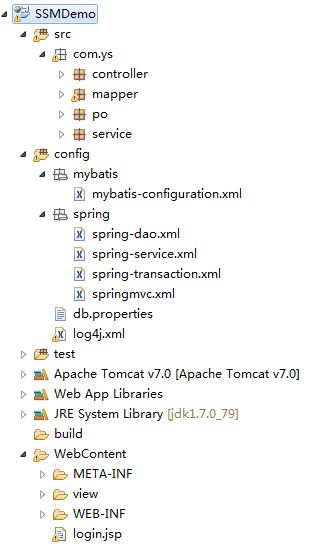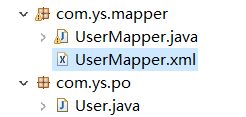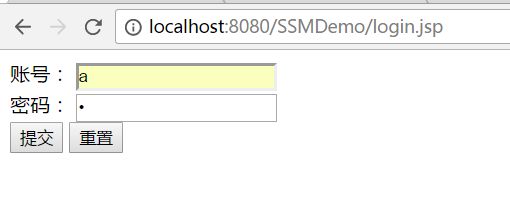为了后面讲解的需要,我们取数据都会从数据库中获取,所以这里先讲讲三大框架(Spring、SpringMVC、MyBatis)的整合。前面讲解 MyBatis 时,写了一篇 MyBatis 和 Spring 的整合,有兴趣的可以先看看:http://www.cnblogs.com/ysocean/p/7368499.html ,那么接下来我们直接进入正题!
本篇博客源码下载链接: https://pan.baidu.com/s/17FmS3FoAs2Ulv4PGug0MCA 密码: skjx
1、整合思路
①、表现层,也就是 Controller,由 SpringMVC 来控制,而SpringMVC 是Spring 的一个模块,故不需要整合。
②、业务层,也就是 service,通常由 Spring 来管理 service 接口,我们会使用 xml 配置的方式来将 service 接口配置到 spring 配置文件中。而且事务控制一般也是在 service 层进行配置。
③、持久层,也就是 dao 层,而且包括实体类,由 MyBatis 来管理,通过 spring 来管理 mapper 接口,使用mapper的扫描器自动扫描mapper接口在spring中进行注册。
很明显,spring 在三大框架的整合中占据至关重要的地位,类似于一个大管家,将 MyBatis 和 SpringMVC 揉合在一起。
2、准备环境
①、数据库环境
数据库类型:MySQL 5.1
数据库名称:ssm
数据表:user
②、开发工具 eclipse
③、JDK 1.7
④、mybatis 3.3
⑤、SpringMVC 4.2.4
⑥、Spring 4.2.4
⑦、数据库连接池 dbcp1.2.2
⑧、数据库驱动包mysql5.1.26
⑨、日志 log4j 1.2
案例需求:输入用户名和密码进行登录验证
具体的 jar 下载见上面的源码下载链接!
项目的目录结构为:
3、整合 Dao 层
也就是整合 MyBatis 和 Spring
①、在 db.properties 文件中,保存数据库连接的基本信息
#db.properties
dataSource=org.apache.commons.dbcp.BasicDataSource
driver=com.mysql.jdbc.Driver
url=jdbc:mysql://localhost:3306/ssm
username=root
password=root
分别是数据库连接池数据源,数据库连接驱动,数据库连接URL,数据库连接用户名,数据库连接密码
②、mybatis全局配置文件 mybatis-configuration.xml
通过 mapper 接口来加载映射文件,具体可以看这篇博客:http://www.cnblogs.com/ysocean/p/7301548.html,必须满足下面四点:
1、xxxMapper 接口必须要和 xxxMapper.xml 文件同名且在同一个包下,也就是说 UserMapper.xml 文件中的namespace是UserMapper接口的全类名
2、xxxMapper接口中的方法名和 xxxMapper.xml 文件中定义的 id 一致
3、xxxMapper接口输入参数类型要和 xxxMapper.xml 中定义的 parameterType 一致
4、xxxMapper接口返回数据类型要和 xxxMapper.xml 中定义的 resultType 一致
③、配置 Spring 文件
我们需要配置数据源、SqlSessionFactory以及mapper扫描器,由于这是对 Dao 层的整合,后面还有对于 业务层,表现层等的整合,为了使条目更加清新,我们新建 config/spring 文件夹,这里将配置文件取名为 spring-dao.xml 放入其中。
spring-dao.xml
④、根据逆向工程生成 po 类以及 mapper 文件
如何使用逆向工程,可以参考这篇博客:http://www.cnblogs.com/ysocean/p/7360409.html,我们逆向工程要是一个额外的工程,生成我们所需的po类以及mapper文件后,在将其复制到我们当前项目中,如下:
由于我们这里是进行登录验证,所以在 UserMapper.java 中添加如下代码:
package com.ys.mapper;
import com.ys.po.User;
import java.util.List;
import org.apache.ibatis.annotations.Param;
public interface UserMapper {
//通过用户名和密码查询User
User selectUserByUsernameAndPassword(User user);
}
UserMapper.xml
dao 层整合完毕之后,我们进行一个测试,要养成每做完一个小模块必须测试的习惯。步步为营,如果整个项目配置完了然后在进行测试,那么有问题进行排除会变得很困难。
package com.ys.test;
import org.junit.Before;
import org.junit.Test;
import org.springframework.context.ApplicationContext;
import org.springframework.context.support.ClassPathXmlApplicationContext;
import com.ys.mapper.UserMapper;
import com.ys.po.User;
public class DaoTest {
ApplicationContext context = null;
@Before
public void init(){
context = new ClassPathXmlApplicationContext("classpath:spring/application-dao.xml");
}
@Test
public void testSelectByPrimaryKey(){
UserMapper userMapper = (UserMapper) context.getBean("userMapper");
User user = userMapper.selectByPrimaryKey(1);
System.out.println(user.getPassword());
}
}这里是根据 user 表的 id 进行查询。如果能打印出user对象的值,那么前面的配置是 OK的。
4、整合 service
前面我们整理了,这层就是用 Spring 来管理 service 接口,我们会使用 xml 配置的方式来将 service 接口配置到 spring 配置文件中。而且事务控制也是在 service 层进行配置。
这里我们以登录
①、定义 service 接口
package com.ys.service.impl;
import com.ys.po.User;
public interface IUserService {
//通过用户名和密码查询User
public User selectUserByUsernameAndPassword(User user);
}
②、编写 service 实现类
package com.ys.service;
import org.springframework.beans.factory.annotation.Autowired;
import com.ys.mapper.UserMapper;
import com.ys.po.User;
import com.ys.service.impl.IUserService;
public class UserServiceImpl implements IUserService{
@Autowired
private UserMapper userMapper; //通过@Autowired向spring容器注入UserMapper
//通过用户名和密码查询User
@Override
public User selectUserByUsernameAndPassword(User user) {
User u = userMapper.selectUserByUsernameAndPassword(user);
return u;
}
}
通过@Autowired向spring容器注入UserMapper,它会通过spring配的扫描器扫描到,并将对象装载到spring容器中。
③、在spring容器中配置 Service 接口,这里我们使用 xml 的方式
在 config/spring 目录下,新建 spring-service.xml
④、在spring容器中配置 事务处理
在 config/spring 目录下,新建 spring-transaction.xml
4、整合 SpringMVC
①、配置前端控制器
在 web.xml 文件中添加如下代码:
SpringMVC_01
springmvc
org.springframework.web.servlet.DispatcherServlet
contextConfigLocation
classpath:spirng/springmvc.xml
springmvc
/
②、配置处理器映射器、处理器适配器、视图解析器
在 config/spring 目录下新建 springmvc.xml文件
③、编写 Handler,也就是 Controller
在 com.ys.controller 包下新建 UserController.java 文件
package com.ys.controller;
import org.springframework.beans.factory.annotation.Autowired;
import org.springframework.stereotype.Controller;
import org.springframework.web.bind.annotation.RequestMapping;
import org.springframework.web.servlet.ModelAndView;
import com.ys.po.User;
import com.ys.service.impl.IUserService;
@Controller
public class UserController {
@Autowired
public IUserService userService;
@RequestMapping("/login")
public ModelAndView login(User user){
ModelAndView mv = new ModelAndView();
User u = userService.selectUserByUsernameAndPassword(user);
//根据用户名和密码查询user,如果存在,则跳转到 success.jsp 页面
if(u != null){
mv.addObject("username", u.getUsername());
mv.addObject("user", u);
mv.setViewName("view/success.jsp");
}else{
//如果不存在,则跳转到 login.jsp页面重新登录
return new ModelAndView("redirect:/login.jsp");
}
return mv;
}
}
④、加载 Spring 容器
我们在 classpath/spring 目录下新建了 spring-dao.xml,spring-service.xml,spring-transaction.xml 这些文件,里面有我们配置的 mapper,controller,service,那么如何将这些加载到 spring 容器中呢?
在 web.xml 文件中添加如下代码:
contextConfigLocation
classpath:spring/spring-*.xml
org.springframework.web.context.ContextLoaderListener
由于配置文件比较多,我们使用通配符加载的方式。注意:这段代码最好要加在前端控制器的前面。
至此 SSM 三大框架整合就完成了,接下来我们进行测试。
5、测试
在 WebContent 目录下创建 login.jsp 页面,以及 success.jsp页面,如下图:
login.jsp
<%@ page language="java" contentType="text/html; charset=UTF-8"
pageEncoding="UTF-8"%>
Insert title here
success.jsp
<%@ page language="java" contentType="text/html; charset=UTF-8"
pageEncoding="UTF-8"%>
Insert title here
Hello ${user.username}
1、将项目发布到 tomcat,如何发布可以参考这篇博客:http://www.cnblogs.com/ysocean/p/6893446.html
2、在浏览器输入:http://localhost:8080/SSMDemo/login.jsp
点击提交:






